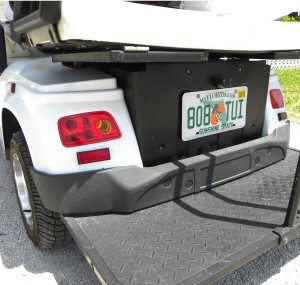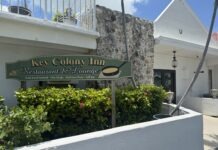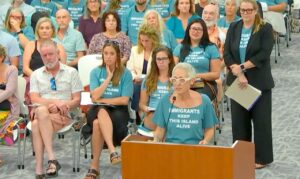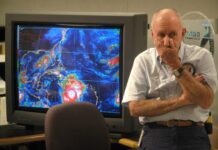
Neighborhood Electric Vehicles must be registered through DMV
Scooters and every form in which they come have long been a popular and more fuel-efficient mode of travel for Keys folks running errands and back and forth to work.
At the April 26 regularly scheduled meeting of the Marathon City Council, Councilman Pete Worthington said a resident had recently asked about whether or not the operation of electric golf carts, rising in popularity along with the price of fuel, were legal to operate on the city’s roadways.

Councilman Mike Cinque asked attorney Joe Jiminez, standing in for regular council John Herin, whether or not the city is covered under state statutes that permit neighborhood electric vehicles (NEVs) on streets with an established speed limit of 35 miles per hour, and after some research, Herin reported this past Tuesday evening that Cinque was in fact correct.
Herin expressed some concern with enforceability because of ambiguous language in the state legislation.
“There are safety requirements absent in the state law, and as awkward as it sounds, if you increase safety requirements, you would be decreasing enforceability rights,” Herin said.
Capt. Chad Scibilia of the Monroe County Sheriff’s Office clarified for The Marathon Weekly not only the differences between a golf cart and low speed vehicle, but the ambiguity in the language as well.
If the City of Marathon were to enact their own ordinance with additional safety requirements beyond what is outlined in the state statutes (see sidebar for specific requirements), it would only apply to unlicensed drivers. So, even a driver with a suspended license but with all the proper equipment and registration would not be subject to ticketing.
“So, if someone wants to register (their vehicle) they should go to the sheriff’s office,” Worthington asked of Herin, who replied that just like any type of vehicle with minimum safety requirements, should be registered with the Department of Motor Vehicles. He further clarified that without proper registration and insurance, such vehicles would in fact be in violation of state law.

After a bit of discussion amongst the council, research by legal staff and full vetting by the sheriff’s office, the difference between golf carts and low speed vehicles has been clearly defined for both residents and local law enforcement, but the city enacted no new ordinances with regard to operation of neighborhood electric vehicles.
Golf carts are defined as motor vehicles designed and manufactured for operation on a golf course for sporting or recreational purposes and not capable of exceeding speeds of 20 miles per hour.
Low-speed vehicles are defined as any four-wheeled electric vehicle whose top speed is greater that 20 miles per hour but not greater than 25 miles per hour, including neighborhood electric vehicles.
Low speed vehicles may be operated only on streets where the posted speed limit is 35 miles per hour or less. This does not prohibit a low-speed vehicle from crossing a road or street at an intersection where the road or street has a posted speed limit of 35 miles per hour. (That means conceivably that low speed vehicles could be used on U.S. 1 in Old Towne Marathon.)
Low speed vehicles must be equipped with:
• headlamps
• stop lamps
• turn signal lamps
• taillamps
• reflex reflectors
• parking brakes
• rearview mirrors
• windshields
• seatbelts
• vehicle identification numbers
Registration and insurance as well as a valid driver’s license is required for operation of a low speed vehicle.
In other business:
• Council voted to bring the permitting and inspection of abandonment of septic systems and cesspools previously performed separately by the Monroe County Department of Health at a cost of $95 per inspection.
Per staff’s recommendation, council approved an amendment to the Building Code Fee Schedule to include the plumbing permit fee for abandonment of septic systems and cesspools for $50. The fee would be retained by the city to recover the cost of performing the permitting, inspection and reporting of abandonment as required to be in compliance with Florida Administrative Code and monthly submittal of departmental reports to DOH.
• A streetlight pilot project along the Aviation Blvd. bike path is still in need of further examination before additional lights are installed.
“This all came about because of residents complaining to the city and asking us to do something,” said Vice Mayor Dick Ramsay. “Two test lights went up with the help of Mike Puto who served on the board of the electric co-op, and residents there have said they’ve been a tremendous help. However, as of right now, the service area would not go past Harbor Drive because there are no posts for lights in the curve.”
Ramsay continued that six additional lights were ready to be installed at an average cost of $12-15 per month, but council waited to approve installation until each member had a chance to review the proposed diagram of specific placement.
“I’ve had a couple of residents who bought houses on Aviation with lights in front of them that they’ve been subject to paying for for years,” said Mayor Ginger Snead, and the council agreed to report back at the next meeting.
• The council also unanimously agreed to extend the right of way permit for the Educational Coalition of Monroe County’s Incredible Fruit Stand.
“They’ve been in compliance with their permit we issued in December,” noted City Manager Roger Hernstadt. “I’ve had no complaints with regard to their operation.”
“I think that operation is important for the community, and I’m glad everything’s working out for them to support the CAMP program,” Worthington said.
• At the conclusion of the meeting, Ramsay reported he’d spoken with resident Rich Thompkins who currently holds the contract to rake both Sombrero and Cocoplum beaches for the city.
“I originally voted him in because he’s a good person, but right now, I’m not sure if he’s the right person for the job,” Ramsay noted, adding that recent report of Community Services Director Susie Thomas said the contractor had been placing excess seaweed blown in with prevailing east winds had been placed in the upper part of adjacent wetlands.
“I would like to see this item up for discussion on the next agenda,” Ramsay requested.
Snead agreed, adding that residents needed the opportunity to appear before the council to vet the issue.





















